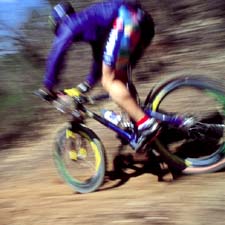| The Mountain Bike Experience |

SEACOAST BY BIKE
When your mother warned you not to play in traffic, is this really what she had in mind? This week we go off-road to examine the mountain bike phenomenon. The Great Balkini takes to the trails. And that is where, he says, these costly, high-tech machines should stay.
ABOUT the Great Balkini
For those prepared to jump into the mountain bike experience there are several straightforward choices. For easy trail riding a basic mountain bike without shocks is the least expensive to buy and maintain. All come with triple chain rings in front and up to nine rear sprockets; that’s 27 gear choices that will handle virtually any terrain including the relatively flat dirt trails meandering through our rural seacoast landscape.
Quick Tip: All the major brands offer great value throughout their lines and buy from a bike shop where they actually ride mountain bikes. (See Buying a Bike)
Mountain bikes -- with their wider tires and an upright seating position -- appear more comfortable than the standard drop bar road bike and therefore seem easier to ride. They’re not. Comfort on a bike gets automatically dialed-in as muscles grow stronger with repetition and is therefore earned through time in the saddle.
Regrettably, perception rules as there are way too many people riding mountain bikes on the road. "Hey, at least they’re on a bike. Good for them," I hear some of you whispering out there, but read on.
For challenging off-road riding, suspension front and rear offers greater control for the focused rider. Nothing new here, shocks absorb bumps enabling the rider to negotiate obstructions and search for the best possible line. Front shocks make it less difficult to hold onto the bars. For even the casual off-road rider they are a worthwhile expense. The distance the shock travels, from one to five inches or more, is tied to the terrain, the more rugged requiring more "travel" in the shock.
Dual front-and rear wheel suspension comes at a price, both in the initial purchase and in later maintenance. The additional weight, complexity and tendency of rear suspensions to rob some of the rider’s power are all part of a package that’s supremely useful off-road. But on tarmac, where these bikes are out of their element, it is all wasted.
These bikes are designed to be ridden aggressively over any and all terrain and can handle conditions that require skill, total concentration and even recklessness to negotiate. Again, that comes at a price. Even mild impact causes parts to bend, break or wear out.
Rising in dirt and slop too takes a toll. Sand in the gears is a metaphor for trouble. Mountain bikes became the best selling cycles for several years, but lost their mass appeal when the cost of keeping them working often exceeded the initial cost of the bike. That’s an anathema to an industry firmly rooted in a cost conscious sub-culture.
Most high-tech recreational activities are expensive and many are demanding. Mountain biking is both, and dangerous to boot. It’s a great activity for those willing to pay whatever it costs to keep the bike going well and are not afraid to take a few lumps themselves.
Riding mountain bikes on the road, however, turns them into beasts. I’ve done it more than enough to know. My first mountain bike was a cheap, but beautiful retro-orange hardtail equipped with one step above entry-level components. My plan was to explore the local woods. I also bought a second set of wheels with slick tires for riding on winter roads too salty, sloppy and gritty for my road bike. Not incidentally, the extra wheels cost as much as the bike.
On warmer winter days I took that bike the equivalent of 20 "road" miles -- but I am spoiled rotten by equipment that works perfectly. The mountain bike gears were too wide for tarmac with only three or four gear ratios useful, and getting to them took forever since the chain had to negotiate wide jumps that the cheap components could not manage efficiently. Slick tires made those rides better than nothing, but not by much.
Unfortunately, most mountain bike road riders that I see are on the knobby tires that come with the bike. Those things glue themselves to the road. For those who think more work equals more exercise, try playing tennis with five-pound weights on each ankle. That’s more exercise too, but no fun either. The same principle applies here.
So back to the woods where these bikes belong. With knobby tires my orange hardtail handled some sloppy conditions on nearby trails with only a few minor tumbles. Encouraged, I bought a halfway decent dual suspension bike, but soon found I was overmatched by the terrain that my more experienced friends were used to.
Becoming accomplished under those conditions demands a different set of skills that are harder to master than riding a road bike in a straight line over smooth terrain. Also influencing my decision, was the annoying reality of taking a few tumbles and landings on miscellaneous objects. That is completely unlike road riding where danger haunts the rider, but where falling off is rare and roads are hard, but smooth. That’s why you’ll see me on the roads, and not in the woods.
With all the real world caveats, mountain biking still enjoys a strong following of riders many of whom maintain their own bikes. Most find road riding boring and the traffic intolerable. Every mother’s mantra is -- don’t play in traffic -- so we roadies can throw no stones at the mountain riders.
READ MORE cycling articles
Copyright © 2005 by David Balkin. All rights reserved.
